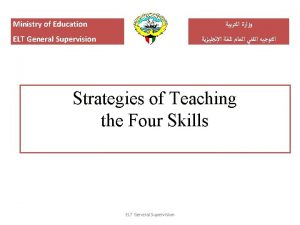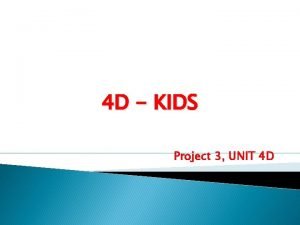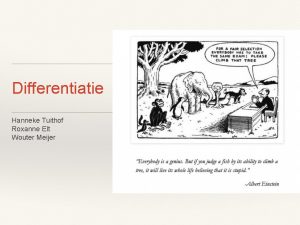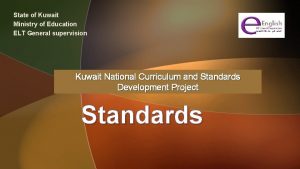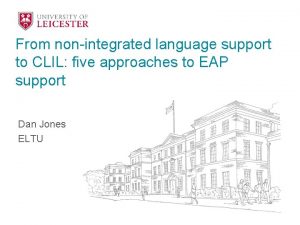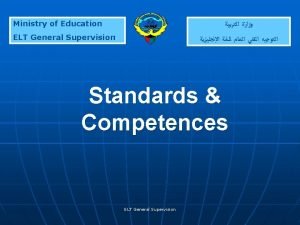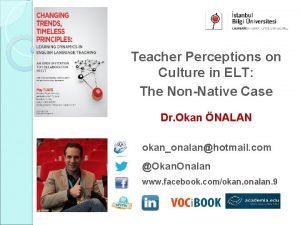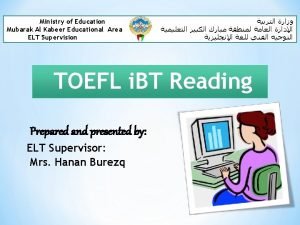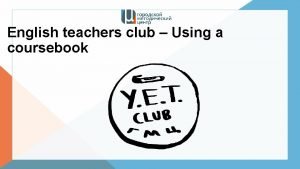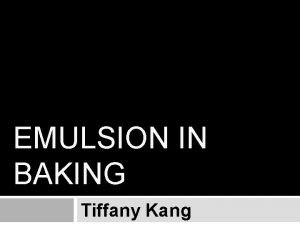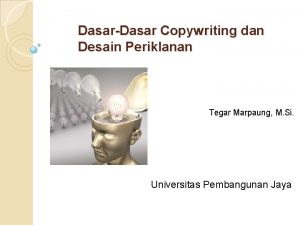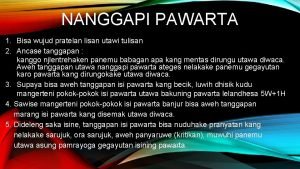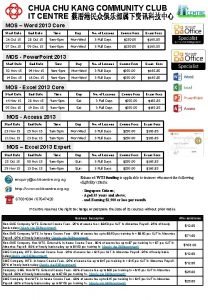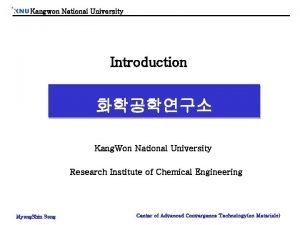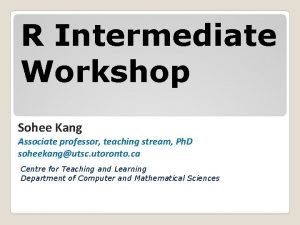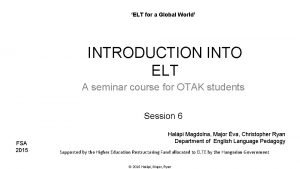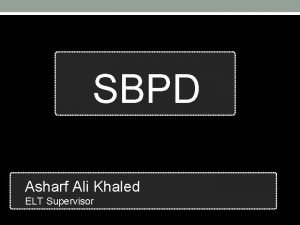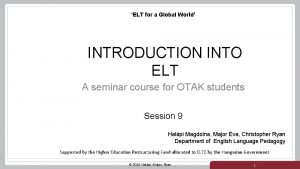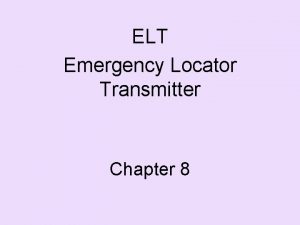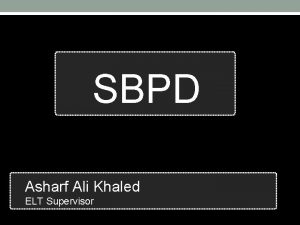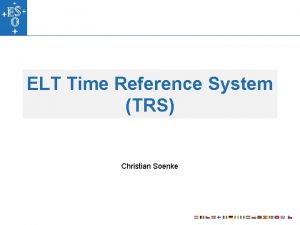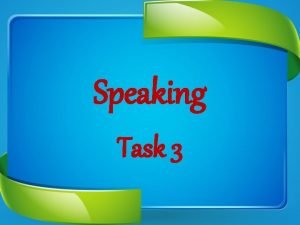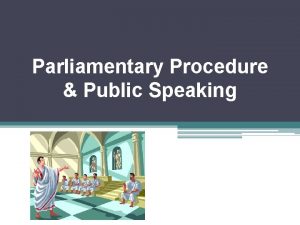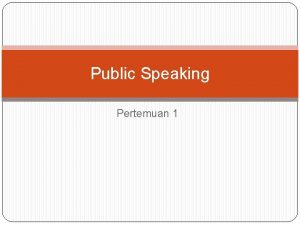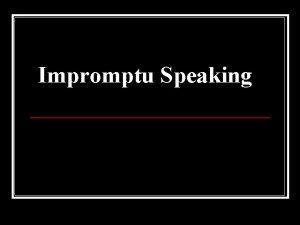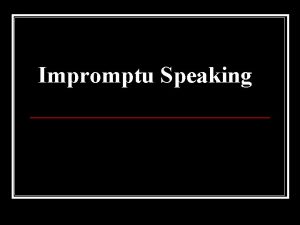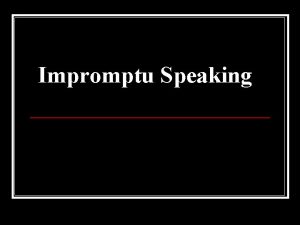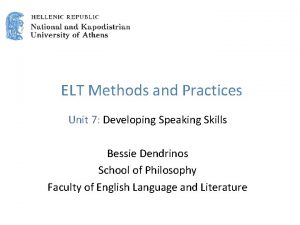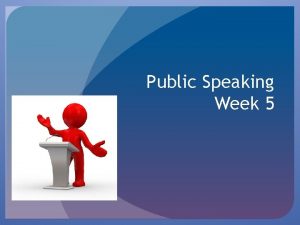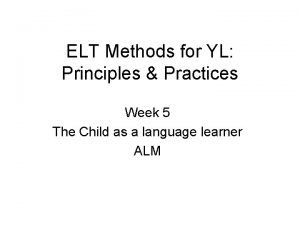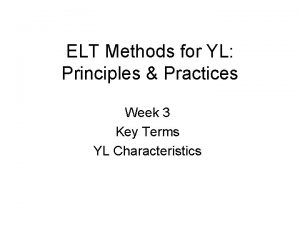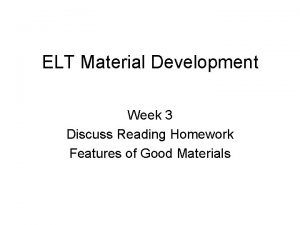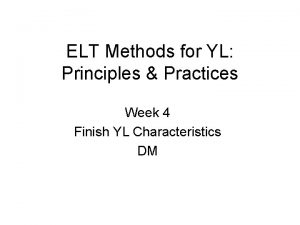Speaking Week 4 NJ Kang Speaking in ELT













































- Slides: 45

Speaking Week 4 NJ Kang

Speaking in ELT Pedagogy in the Context of Bangladesh: An Overview of Problems and Recommendations • Md. Tariqul Huq Lecturer, Department of English, University of Barisal, Bangladesh • American Journal of Humanities and Social Sciences Vo 1. 2, No. 1, 2014, 70 -75 DOI: 10. 11634/232907811402515 • Print

RQ 1. Review some issues and strategies encompassed within the speaking pedagogy in ELT and tried an application of these in the context of classroom teaching of speaking skill in Bangladesh, 2. Background: Learner’s shyness to speak in English, his ineluctable mental habit of thinking in Bangla and translating them in English, insufficiency of need-based English courses, a felt absence of an enhancing environment for the promotion of this particular skill both inside and outside the classroom. To understand whether these already existing theories and methods relating to speaking skill would be applicable in Bangladesh.

• Ineluctable: inevitable • Perennial issues • Paradigmatic limit

Theoretical Perspective of Speaking Skill-Getting: Cognition (Knowledge) Production (Pseudo-communication) Skill-Using: Interaction (Real communication) Perception (units, functions, categories) Abstraction (internalizing rules to functions) Articulation (practice of sequence of sounds) (Construction (practice in formulating communications) Reception (comprehension of a message) Expression (conveying personal meaning)

Hymes’s (1972) theory of communicative competence • is a definition of what a speaker needs to know in order to be communicatively competent in a speech community. • Characteristics of communication • Language is a system for the expression of meaning. • The primary function of language is to allow interaction and communication. • The structure of language reflects its functional and communicative uses. • The primary units of language are not merely its grammatical and structural features, but categories of functional and communicative meaning as exemplified in discourse.

when speaking skill is aimed at the maximisation of the benefits of the communicative competence • it has to take into account both discursive and functional dimensions of language. • While the discursive dimension pertains to the social and cultural knowledge of the language, • the functional one deals with a set of strategies and devices that a speaker deploys while facing the contingencies of speaking such as time- constraint, contextual adjustment, anticipation, compulsory reciprocation etc.

The theoretical aspect of speaking is notably underpinned by Bygate (1987, 3) • Two fundamental components of speech • production and interaction. • Oral production, the speaker undergoes the process of either ‘facilitation’ or ‘compensation’, both of which requiring the speaker to use adjustive tools to the context such as simplifying structures, formulaic expression, ellipsis, fillers, hesitation devices or self correction etc

The objectives of the facilitative and compensatory devices • of ease to the oral production and make the speaker feel at home about the task of speech delivery. • The interactional component within speaking focuses on the aspect of good communication and the management of the communication by which the message is made explicit and understandable to the listener. • Routines and negotiation. • The routines aim at shaping the conversation with comprehensive patterns such as description, comparison, instruction, • Negotiation introduces choice of the topic or involves the turntaking between the speaker and listener.

Harmer (2001) • Speaking is sophisticated skill depending on synthesis of certain necessary factors for successful operation • The success of speaking, among all other skills, is directly contingent upon the knowledge of language teaching and the ability to process information on the spot, which means the speaker’s social perception and his instant mental reflex to it. • stresses on the need for the management and negotiation of language through discreet measures like connected speech, expressive devices and suggests, thereby, a consistent programmatic approach in teaching speaking skill in ELT pedagogy.

So teaching speaking • It can be observed here that what Harmer and Bygate prescribe for the efficacy of the teaching and learning of the speaking skill- discursive awareness of language and access to well-thought out strategies

Canale and Swain’s(1980) communicative competence • grammatical competence, • sociolinguistic competence, • discourse competence, • strategic competence.

Background of the research • Shyness of the learner �Pronunciation: students are worried about mistakes �Lack of practice and opportunities �Limited vocabulary and syntax �Influence of Grammar Translation method: students are over conscious of Grammar �Low or uneven participation �Use of mother tongue �Lack of training environment �Insufficient knowledge of target language. • Large class : 130 sts in a class • Short lesson hour : less than 45 min. • Lack of teacher training and teacher quality: can teach without teacher certificate • Examination focused, grammatical competence focused, gtm highlighted

Suggestions • Breen and Candlin (1980: 99), • “the teacher has two main roles: the first role is to facilitate the communication process between all participants and the various activities and the texts. The second role is to act as an independent participant within the learning- teaching group”. • Jeremy Harmer (1991) • Acting from a script: �Playscripts: Communication games: � Instant comment: �Unplanned discussion �Reaching a consensus �Formal debate: Simulation and role play

Littlewood (1981), • Two types of activities: “functional communication activities” and “social interaction activities”. • Functional communication activities include such tasks as learners comparing sets of pictures and noting similarities and differences, working out a likely sequence of events in a set of pictures, discovering missing features in a map or pictures; following directions; and solving problems from shared clues. • Social interaction activities include conversation and discussion sessions, dialogues and role plays, simulations, skits, improvisations and debates

An exploratory study of Hong Kong students’ perceptions of native and nonnative English-speaking teachers in ELT • Chit Cheung Matthew Sung* • Department of English, Lingnan University, Tuen Mun, New Territories, Hong Kong, China (Received 24 April 2013; accepted 4 October 2013)

RQ • The perceptions of Hong Kong secondary students towards native Englishspeaking teachers (NESTs) and non-native English-speaking teachers (NNESTs). Methods • Qualitative data were collected by means of semi-structured interviews with 25 students from four secondary schools. Results • the participants identified the strengths and weaknesses of both NNESTs and NESTs. • NESTs ü Strengths: use of interactive teaching styles and their accurate pronunciation, ü Weaknesses: teaching of grammar and examination skills. • NNESTs ü Strength: competent in the teaching of grammar and examination strategies, ü Weaknesses: the use of relatively ‘traditional’ teacher-centered teaching methods and their inaccurate pronunciation. • Strengths and weaknesses of NESTs and NNESTs are largely complementary.

Background • Numbers of ES • native English-speaking teachers (NESTs) are often preferred over non-native English-speaking teachers (NNESTs) when employment decisions are made, and cases of discrimination against NNESTs have been reported (e. g. Braine, 2010; Clark & Paran, 2007) • However, several scholars (e. g. Canagarajah, 1999) have questioned whether NESTs are ‘intrinsically better qualified’ (Phillipson, 1992, p. 194) than NNESTS.

Literature Review • The dominance approach and the difference approach. • In the former approach, the main assumptions are premised on the paradigm of ‘deficit linguistics, ’ whereby NNESTs are viewed as linguistically handicapped in relation to NESTs. • The difference approach, on the other hand, emphasizes that both NNESTs and NESTs are equally capable of being good language teachers, regardless of their linguistic backgrounds (Medgyes, 1992)

Butler (2007) NESTs among Korean elementary students. • In particular, she found significant differences in the students’ attitudes towards teachers with American-accented English and Korean-accented English with regard to their ‘goodness of pronunciation, ’‘confidence in their use of English, ’ and ‘focus on fluency vs. accuracy, ’ but not regarding ‘general teaching strategies. ’ • It was also found that the American-accented teacher was perceived to speak English with a better pronunciation and show more confidence in speaking English.

Pacek (2005) • explored the perceptions of two groups of ESL students taught by the same NNEST at a university in the UK. • Her study showed that the students expressed favorable views concerning their NNESTs, provided that they can meet students’ expectations by using appropriate teaching methods and by displaying personality features favored by the students. • Overall, while there have been inconsistent results over students’ preference for NNESTs, most studies have shown that most students do not seem to hold a negative attitude towards their NNESTs or NESTs (cf. Moussu & Llurda, 2008).

The Impact of Multiple Intelligences-Based Instruction on Developing Speaking Skills of the Pre-Service Teachers of English • Ashraf Atta M. S. Salem 1 1 Ph. D in TEFL, Institute of Educational Studies & Researches, Cairo University, Egypt Correspondence: Ashraf Atta M. S. Salem, State of Kuwait, Mahboula, Block 1, Street 131, Building 24, behind Alhashel Complex. E-mail: sirashrafams@hotmail. com • Received: June 11, 2013 Accepted: July 2, 2013 Online Published: August 15, 2013 doi: 10. 5539/elt. v 6 n 9 p 53 URL: http: //dx. doi. org/10. 5539/elt. v 6 n 9 p 53

RQ • The impact of multiple intelligences-based Instruction on developing speaking skills of the pre-service teachers of English. • Therefore, the problem of the current study can be stated in the lack of speaking skills of the pre-service teachers of English in Hurgada faculty of Education, South Valley University. • What is the effectiveness of a Multiple-Intelligence based program in developing EFL prospective teachers of speaking skills 1) What are the speaking skills required for the fourth-year prospective teachers of English? 2) What is the actual performance of prospective teachers of English in speaking skills? 4) What is the Multiple Intelligences profile of the prospective teachers of English? 5) What are the principles of Multiple-Intelligences based instruction in developing EFL prospective teachers’ speaking skills? 6) What is the effect of a Multiple Intelligences based program in developing the speaking skills of the prospective teachers of English?

• Subjects: sixty fourth-year Prospective teachers of English. • Method: • A multiple-intelligences based program to enhance the speaking skills paying a due attention to the individual differences among students. • The Quasi-experimental research design was used in the study as the researcher used the one group pre-posttest to assess the usefulness of using this approach. • Results of the study proved the effectiveness of Multipleintelligences based Instruction on developing speaking skills of the pre-service teachers of English.

Experimental Manipulations and Intervention • A Checklist of Students’ Speaking Skills • Multiple Intelligences Inventory for EFL Young Adults (Mc. Kenzie, 1999) • The Speaking Pre-Posttest a. Aim of the test The test was used to develop giving oral presentations, making requests, making suggestions and giving advice in the pre and post testing. b. Description of the test The test was divided into four parts as follows: Part (1) Giving oral presentations. Part (2) Making requests. Part (3) Making Suggestions. Part (4) Giving advice.

The main hypothesis of the study • is that there are statistically significant differences between the mean scores of the experimental group in Students' Performance in Speaking Skills and Subskills. The subskills included in the study are the oral presentation skills, making suggestions, making requests, and giving advice.

Literature Review • MI Theory calls for multi-modal teaching strategies in which students are given more chances or options while they are learning and speaking. Multiple intelligences theory based instruction helps in involving and reaching more and more students in the learning process because it addresses various types of intelligences whether these intelligences are scholastic (verbal/linguistic intelligences and the logical/mathematical intelligences) or non-scholastic intelligences ( interpersonal, intrapersonal, and bodilykinesthetic intelligences, etc. ).

Speaking • skills have been found a fundamental skill necessary for a person’s success in life. Speaking skills cover a wide range, from engaging in simple conversation to formal public speaking. • is the target skill in both first and foreign languages. (EI-Basel, 2008: 77). • skills play a vital role in communication process. (Dorgham, 2011: 1). • skill, is a complicated skill as it involves many processes or operations working together. (Sayed, 2005: 42) • requires that learners not only know how to produce specific points of language such as grammar, pronunciation, or vocabulary (linguistic competence), but also they understand when, why, and in what ways to produce language (Sociolinguistic competence). (Al-Khuli, 2000: 4), • is a complicated mental process and a productive skill. ” (Ibrahim, 2007: 1) • is not a single skill, rather speaking is an interactive process of constructing meaning that involves producing, receiving and processing information (Brown, 2001: 9) • include two categories; accuracy and fluency (Harmer, 2001: 15)

To be proficient speakers • learners need to acquire the way native speakers use the language in the context of structured interpersonal exchange, and to use the language appropriately in social interactions which are an ability that should be mastered to achieve effective oral communication. • Social interactions include verbal communication, paralinguistic elements of speech such as pitch, stress, and intonation, and nonlinguistic elements of speech such as gesture, body language posture and facial expression that may accompany speech or convey messages.

The current study defines • speaking as “ an interactive process that includes certain skills such as giving oral presentation, making suggestions, making requests and giving advices that foster oral fluency of the prospective teachers of English through the use of at least five types of intelligences ”

The effect of Drama on students’ anxiety of speaking English Lee, Seoyeon Thesis for the Degree of Master, Sookmyung universtiy

RQ • . How do the drama activities affect students’ anxiety level in speaking in English? • 2. What are the factors that affect students' anxiety in speaking in English during the drama activities? • Subjects • 27 female undergraduate students enrolled in the drama class at a university located in Seoul • Methods • survey, observations, reflective journals and interviews,

Literature Review • 2. 2 Anxiety and Language • Definition and types of Anxiety • “a state of apprehension, a vague fear that is only indirectly associated with an object” (Scovel, 1991, cited in Tanveer, 2007, p. 3). • anxiety and fear are both “unpleasant emotional reactions to the stimulus conditions perceived as threatening, ” • fear is usually derived from a “real, objective danger in the external environment” while threatening stimulus of anxiety may not be known. (Speiberger 1976, cited in Wang, 2005, p. 13)

Foreign language anxiety • language anxiety is distinct from any other type of anxiety and is not merely a composite of other anxieties (Horwitz, & • Foreign Language Classroom Anxiety Scale (FLCAS) (Horwitz, and Cope 1986): 33 question items • the three components of foreign language anxiety: communication apprehension, test anxiety, and fear of negative evaluation (Ganschow& Sparks, 1996). Cope, 1986; Mac. Intyre & Gardner, 1991 b).

communication apprehension • is an individual’s level of fear or anxiety associated with either real or anticipated communication with other persons. • Oral communication consists of two components: listening and speaking. Speaking is anxiety-provoking in foreign language activities (Mac. Intyre & Gardner, 1991 c). Daly (1991) and Young (1986) find that most students are particularly anxious when they have to speak a foreign language in front of their class. As to listening, it is a problem for language learners, too. Foreign language learners usually have difficulty understanding others.

Test anxiety • “the tendency to view with alarm the consequences of inadequate performance in an evaluative situation. ” (Sarason 1984). • Test anxiety occurs when students have poor performance in the previous tests. (Chan & Wu, 2000). • Test-anxious students may have false beliefs in language learning. (Horwitz, & Cope, 1986). • Young (1991) claims test anxiety would affect foreign language learners with low levels of oral proficiency more than those with high levels of proficiency. • On the other hand, learners experience more language anxiety in highly evaluative situations. Researchers find that test anxiety could be significantly higher under an official and unfamiliar condition (Daly, 1991; Young, 1991). • an oral test is more complicated because it provokes both test anxiety and oral communication apprehension. (Horwitz, & Cope, 1986), • so test-anxious learners will doubtlessly suffer stress and anxiety frequently.

Positive findings of effect of drama on speaking anxiety Kao (1994) process-oriented drama 23 Taiwanese university students who were learning English. learners gained more confidence in speaking English because the drama-based activities encouraged them to convey their thoughts in an natural way. The learners who felt “afraid” of speaking in the target language prior to the commencement of the course became more confident after participating in the drama program. Other learners with very low self-esteem and lower language proficiency seemed to have benefited less from the course. Coleman (2005) adolescent Korean English learners. Participants ranked the statement “feel more relaxed speaking English” the highest (M = 5. 07). learners ranked the statement “manages anxiety and apprehension” the lowest (M = 2. 12). factors other than the drama instruction might have influenced results. For example, it could be that learners' age affected the results. Piazzoli (2011) process-oriented drama on L 2 learners' anxiety levels. Six process-oriented drama workshops to twelve advanced learners of Italian enrolled in a third-year course at a university in Brisbane, Australia. The workshops included a reflection on Italian socio-cultural issues through discussion, improvisations, and the presentation of formulaic language structures. At the end of each workshop, a forum was provided for learners to reflect on intercultural issues.

Fear of negative evaluation • ‘apprehension about others’ evaluations, distress over their negative evaluations, and the expectation that others would evaluate oneself negatively” (Watson, & Friend, 1969). • Although it is similar to test anxiety, fear of negative evaluation is broader in scope because it is not restricted to test-taking situations. • It may take place in any social, evaluative situation such as interviewing for a job or speaking in foreign language class. • Mac. Intyre and Gardner (1991 d) propose that fear of negative evaluation is closely related to communication apprehension. When students are unsure of what they are saying, fear of negative evaluation occurs and they may doubt about their ability to make a proper impression. • In a foreign language context, negative evaluation derives mainly from both teachers and their peers because foreign languages require continual evaluation by the teacher and anxious students may also be intensely susceptible to the evaluations of their peers. • Students with fear of negative evaluation might adopt the action of avoidance. (Horwitz, & Cope, 1986).

Impacts of foreign language anxiety on learning • play a vital role in foreign language learning performance. • language anxiety stands high among the factors having influences over language learning no matter that what learning setting is (Oxford 1999).

Affective Filter Hypothesis (Krashen 1982) • only the affective optimal conditions yield language acquisition. • The affective conditions stated here are motivation, self-confidence, and anxiety. • Three stages of language learning (Tobias 1986): input; processing; and output (see Figure 2. 1) • The input stage is associated with the learners’ first experience with a given stimulus at a given time and is said to be the initial representations of the items in memory. In this sense, internal representations are made, and then attention, concentration and encoding occur when encountering external stimuli. • The processing stage relates to the performance of cognitive operations on the subject matters, including organization, storage, and assimilation of the material. So, this stage is concerned with unseen, internal manipulations of items from the input stage. • For the output stage, it involves the production of material previously learned.

Foreign language anxiety and speaking • High levels of anxiety led to low speaking performance and attitudes (Horwitz et al. 1986; Mac. Intyre and Gardner 1991; Phillips 1992; Mc. Intyre & Charos 1995). • Wilson (2006) examined the relationships of overall proficiency of English oral performance, variables in an association with overall proficiency, oral test performance, and foreign language anxiety of a group of tertiary students. The study revealed that there was a statistically significant and negative relationship between language anxiety and oral test grades using two oral performance criteria. • Highly anxious group of students tended to perform oral test grades significantly more poorly than those with moderate and low anxiety. Obviously, high anxiety led to overall poor English proficiency. • Woodrow (2006) studied the debilitating impacts of second language anxiety on oral performance of advanced English for academic purposes (EAP) students studying on intensive EAP courses prior to entering Australian universities.

six potential sources of foreign language classroom anxiety (Young 1991) • He postulates that language anxiety is caused by (a) personal and interpersonal anxiety; (b) learners‟ beliefs about language learning; (c) instructors‟ beliefs about language teaching; (d) instructor-learner interactions; (e) classroom procedures; and (f) language testing. These sources of language anxiety are interrelated.

Possible factors that influence anxiety • speak in front of their friends: a fear of being laughed at, making fools of themselves, and being embarrassed (Price 1991). • oral class presentation is found to be the activity that triggers the most anxiety for the first two years of NA Spanish classes at the University of California, Irvine (Koch and Terrell 1991) • an inability to comprehend what is being taught is a cause of a considerable anxiety (Von Wörde 2003) That is to say, anxiety might be provoked by an inability to listen to a teacher speaking too fast and insisting using English at all times in the class. Students, therefore, cannot keep up during class and they then carry this difficulty over into the homework assignments. These factors, consequently, make students become tense because they cannot clearly perceive what has been taught

Experiments Role plays • Mime • Still image • Scripted role play • Play scripts • Process drama • Juxtaposition • One-word drama • Simulation • Debating

Homework • Read and summarize. • Your research questions and methods, subjects.
 Week by week plans for documenting children's development
Week by week plans for documenting children's development Dias de semana
Dias de semana Elt supervision
Elt supervision Elt supervision
Elt supervision Elt.oup student project
Elt.oup student project Roxanne elt
Roxanne elt General elt
General elt Language
Language Elt general supervision kuwait
Elt general supervision kuwait Beaconregistration noaa gov
Beaconregistration noaa gov Repak elt members
Repak elt members Okan elt
Okan elt Will + infinitive
Will + infinitive Direct approach in teaching
Direct approach in teaching Morphology meaning linguistics
Morphology meaning linguistics Mubarak elt supervision
Mubarak elt supervision English teachers club
English teachers club Elt supervision
Elt supervision Tembang dhandhanggula wonten malih tuladhan prayogi
Tembang dhandhanggula wonten malih tuladhan prayogi Prasasti tuk mas yang berisi atribut dewa
Prasasti tuk mas yang berisi atribut dewa Types of emulsion
Types of emulsion Lahini arunachalam
Lahini arunachalam Alur kang runtut saka wiwitan nganti pungkasan
Alur kang runtut saka wiwitan nganti pungkasan Wayang purwa kagawe saka.........
Wayang purwa kagawe saka......... Tata urutan nulis karangan narasi yaiku
Tata urutan nulis karangan narasi yaiku Tan anganggo tegese
Tan anganggo tegese Important quotes in macbeth
Important quotes in macbeth Talataan
Talataan Contoh sub headline
Contoh sub headline Sage termasuk prosa lawas
Sage termasuk prosa lawas Apa ciri-cirine pawarta
Apa ciri-cirine pawarta Direct method of teaching english
Direct method of teaching english Atur panyaruwe yaiku
Atur panyaruwe yaiku Chua chu kang cc
Chua chu kang cc Sanepa yaiku ....
Sanepa yaiku .... Wacana eksposisi yaiku wacana kang nyritakake ....
Wacana eksposisi yaiku wacana kang nyritakake .... Unggah ungguh yaiku
Unggah ungguh yaiku Kepriye carane maca pawarta kang bener
Kepriye carane maca pawarta kang bener Mandeep kang
Mandeep kang Grebeg maulud kanggo mengeti
Grebeg maulud kanggo mengeti So-hee kang utsc
So-hee kang utsc Sing kepanjing prosa rayat yaiku….
Sing kepanjing prosa rayat yaiku…. Bj kang
Bj kang Basane wong kang lagi nesu yaiku
Basane wong kang lagi nesu yaiku Kd kang
Kd kang Woowon kang
Woowon kang



